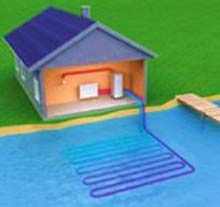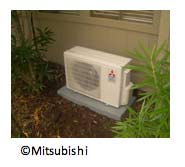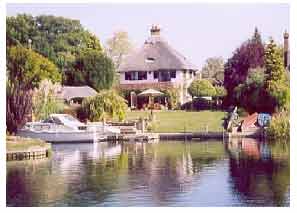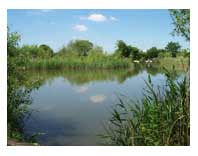With the drive today to stop using fossil fuels, many new gren and alternative technologies have emerged with the potential to take it’s place that offer an environmentally friendly solution and in most cases, also a potential sizeable saving on energy bills.
One such technology is the water source heat pump, so in this guide we take a detailed look at this exciting area.
Water Source heat pumps: The Basics
A water source heat pump is a smart heating and cooling system that taps into the steady, consistent temperature of water sources like lakes or underground wells and utilises this to help heat and regulate an indoor climate.
Unlike traditional systems, which burn fuel or rely solely on electricity, water source heat pumps harness the natural warmth of water to heat buildings in winter and release excess heat back into the water during summer for cooling.
These systems contain essential components like compressors, evaporators, and condensers, which work together to extract heat from the water, compress it to boost its temperature, and then release it indoors.
This process is highly energy-efficient, as it maximises the use of renewable resources and reduces reliance on fossil fuels. With lower energy costs and reduced environmental impact, water source heat pumps offer a sustainable solution for comfortable indoor environments year-round.

House showing installed Water Source Heating pipework
Closed vs. Open Loop Systems
A ground loop, composed of piping, gathers heat from either the ground or a water source and transports it to the heat pump. In water source heat pump setups, the ground loop can be configured in two ways:
- Closed Configuration: This mimics the setup of a ground source system, with a loop of piping submerged in a water source. It contains a mixture of water and antifreeze to collect ambient heat from the water, which is then transferred to the fluid and carried to the heat pump.
- Open Configuration: In this setup, the source water itself is pumped into the system and then returned to the water source after the heat extraction process. Open systems are generally considered more efficient but require more maintenance.
Installing this system can reduce home heating costs, although savings may vary as it’s not widely adopted.
The Renewable Heat Premium Payments scheme (unfortunately now ended) once offered a voucher of £1,250 towards installation costs for those with oil, solid fuel, or electric heating systems.
Additionally, when running the government also provided regular payments to homeowners generating renewable heat through the Renewable Heat Incentive scheme, which started in the summer of 2013, again now ended.
How Water Source Heat Pumps Work
To use a water source heat pump, you’ll need access to a substantial water source like a river or lake nearby. Keep in mind that installation costs might be high, possibly requiring divers or draining the water source.
- A mix of antifreeze and water circulates within a ground loop (series of looped pipework) submerged in the water source, absorbing its heat.
- The heated fluid from the ground loop moves to a heat exchanger, where it transfers its heat to a refrigerant.
- The refrigerant, now heated, undergoes compression via a compressor, increasing its temperature. This heat is then suitable for heating water in a central heating system or for hot water use.
- Once the ground loop fluid cools, it returns to the water, repeating the process by absorbing more heat.
The loop’s length depends on your home’s size and heat requirements. Longer loops can extract more heat but need a larger water area.

Mitsubishi Air Source Heat Pump unit
Other heat pump systems operate similarly but extract heat from different sources:
- Air Source heat pumps: These systems draw heat from external air, offering an economical and easy-to-install option, ideal for urban areas with limited outdoor space.
- Ground Source heat pumps: Similar to water source pumps but with ground loops buried in trenches in your garden.
- MVHR (Mechanical Ventilation and Heat Recovery): This system recovers heat from warm air leaving your house, suitable for well-sealed homes.
Installing a Water Source Heat Pump
To install a water source heat pump, as said, begin by securing the necessary planning and environmental permissions, particularly since it involves using a local water body. Consult the Environment Agency for guidance in this process.
Next, select an MCS accredited installer to ensure eligibility for Renewable Heat Incentive subsidies.
Once permissions are obtained and an installer is chosen, the installation process typically involves several key steps:
- Firstly, the heat pump unit is positioned near the water source, ensuring accessibility for maintenance and repairs.
- Then, the ground loop — a length of piping containing a mixture of water and antifreeze—is submerged into the water source. This fluid absorbs heat from the water and transfers it to the heat pump through a heat exchanger within the unit. The heat pump then compresses the refrigerant, increasing its temperature to heat water for use in a central heating system or for hot water.
- The pipework is then connected to the heat pump unit na the unit itself is then connected up to the heating medium e.g. central heating system or similar.
This is a very basic run down on the installation process and each installation will essentially be different due to differing locations, central heating systems, properties and many other factors.
Regular maintenance and periodic checks are essential to ensure the system operates efficiently and effectively.
Water Source Heat Pump Installation Checklist
If you are considering installing a water source heat pump, ensure that you have considered the following points:
- Planning Permissions: Ensure you secure the necessary permissions before starting the installation process.
- Home Insulation: Proper insulation is crucial to maximise system efficiency. Water source heat pumps operate at lower temperatures compared to traditional boilers, so effective insulation is essential for optimal performance.
- Heating Fuel: If your current heating system relies on electricity, solid fuel, or oil, switching to a water source heat pump can result in significant energy savings. However, homes with gas systems may experience smaller savings. Gas-heated homes may not qualify for certain incentives but in some cases was eligible for assistance through programs like the Green Deal (now finished).
- Heating System Choice: Consider options like under-floor heating, larger radiators, or low-temperature fan convectors, which are more efficient when paired with a heat pump due to the lower water temperatures they require.
- Other Building Work: If you have additional building projects planned, consider combining them with your heat pump installation to potentially reduce costs.
Understanding the Coefficient of Performance (CoP) and System Efficiency Ratio (SER) is essential. The CoP reflects a heat pump’s efficiency by measuring the ratio of heat output to energy input. Look for systems with higher CoP values, as they indicate greater efficiency.
Similarly, SER measures the ratio of electricity units consumed by the entire heating system to the heat pump’s heat production. Aim for systems with high SER values, typically ranging from 1 to around 4, for optimal performance and energy efficiency.

National Trust lake
Water Source Heat Pump Installation Time
The installation duration for a water source heat pump system depends on its size. Combining the installation with other building projects can save money, especially if modifications to the heat distribution system, like installing underfloor heating, are required.
Water Source Heat Pump Installers
When the schemes were running you always had to opt for an MCS accredited installer when installing your heat pump system to qualify for grants and subsidies, which have mostly now ended, however it’s always worth checking if you qualify for any before installing.
These installers possess the required qualifications to ensure compliance with the government’s Renewable Heat Incentive scheme when it was running, but even though it isn’t, it’s still best to use such accredited workers.
However, if you were using the Green Deal to qualify for this scheme when it was running you had to enlist a Green Deal installer for the job.
Water Source Heat Pump Costs
Once installed, the operational costs of a water source heat pump system depend on factors like home size and insulation quality.
Opting for an open-loop water source system may lead to higher maintenance costs but typically offers higher efficiency.
Despite requiring electricity for fluid circulation, heat pumps extract more thermal energy from the water source than they consume, enhancing energy efficiency.
Unlike conventional boilers, heat pumps generate lower temperature heat over extended periods, requiring continuous winter operation for optimal efficiency. Installing Low Surface Temperature (LST) radiators is recommended as they compensate for the heat pump’s lower water temperature output.
At present, installing a water source heat pump can vary in cost depending on several factors. On average, homeowners can expect installation expenses to range from £8,000 to £20,000 or more. These costs encompass various elements such as the size and complexity of the system, any necessary modifications to existing heating infrastructure, labor charges, and geographic location.
It’s crucial to note that while the initial investment may seem significant, water source heat pumps are generally more energy-efficient than traditional heating systems, potentially resulting in long-term savings on utility bills.
To get an accurate estimate tailored to your specific circumstances, it’s advisable to consult with a reputable installer who can assess your property’s requirements and provide a detailed quote.

House situated next to lake
The Advantages of Water Source Heat Pumps
The savings from installing a water source heat pump can vary based on your existing heating system. Furthermore, using an MCS accredited installer qualified you for a £1,250 voucher (Renewable Heat Premium Payment) and regular payments for generated heat (Renewable Heat Incentive) when the schemes were running. It may be worth you checking if any other schemes are currently in operation.
Beyond cost savings, heat pump systems offer additional benefits:
- Reduced Environmental Impact: By reducing the need for burning fuel, heat pumps lower carbon emissions, contributing to a greener environment.
- No Boiler Required: With a heat pump in place, there’s typically no need for a separate boiler to supplement hot water needs.
- No Fuel Deliveries: Since heat pumps operate solely on electricity, there’s no requirement for fuel deliveries, simplifying home heating logistics.

Lake with reeds
Maximising Savings with Water Source Heat Pumps
The amount of energy and money you save with a heat pump depends on various factors:
- Heat Distribution: Under-floor heating is preferable to radiators with a heat pump system as it efficiently disperses heat using lower temperature hot water.
- Existing System Efficiency: If your current system is inefficient, transitioning to a heat pump is likely to yield increased savings.
- Hot Water Production: Using a heat pump for hot water may impact its efficiency.
- Usage Patterns: Heat pump systems may require longer heating periods daily, but you can potentially lower the thermostat temperature while maintaining comfort.
If your property and location provides the required elements for a water source pump system e.g. a suitable water source then such a system can provide reliable heating and decent savings on your energy bills so it’s well worth looking into.

